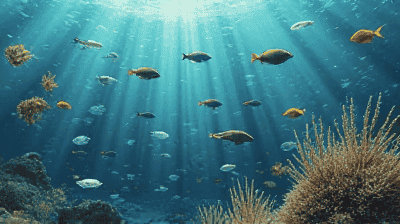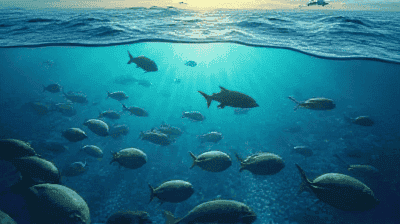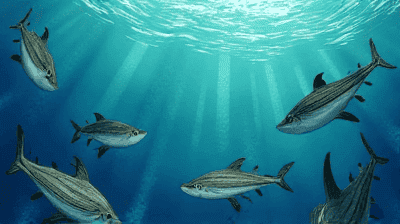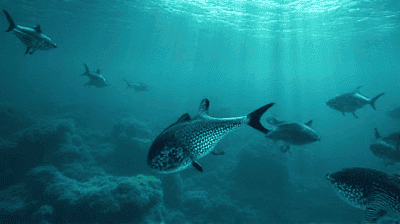
The oceans cover more than 70 percent of the Earth's surface, yet they remain one of the least governed environments on the planet. The high seas, which lie beyond national jurisdiction, account for about two-thirds of the ocean's area and are rich in biodiversity and resources. Despite their importance, these regions have historically been under-protected and over-exploited. However, the recent development of the High Seas Treaty marks a significant step toward safeguarding marine biodiversity and ensuring sustainable use of ocean resources.
The high seas refer to portions of the ocean that are not under the jurisdiction of any single country. Defined as waters that lie beyond the 200-mile Exclusive Economic Zones (EEZs) of coastal nations, the high seas include diverse ecosystems, including deep-sea habitats, migratory routes of marine species, and areas rich in threatened and endangered species.
Marine biodiversity encompasses the variety of life forms in marine environments, including fish, invertebrates, mammals, seabirds, and underwater plants. Healthy marine ecosystems provide numerous benefits:
Ecosystem Services: These include the regulation of climate, carbon sequestration, nutrient cycling, and the provision of food and livelihoods for millions of people.
Cultural Significance: Oceans have deep historical, cultural, and spiritual significance for diverse communities around the world.
Economic Value: The high seas are a source of fisheries, minerals, and hydrocarbons, contributing to the economies of many countries.
Despite their importance, the high seas face significant threats:
Overfishing: Unsustainable fishing practices have led to the decline of numerous fish populations and disrupted marine ecosystems.
Pollution: Marine pollution, including plastics and toxins, poses serious risks to marine life and human health.
Climate Change: Rising sea temperatures, ocean acidification, and other effects of climate change threaten the resilience of marine ecosystems.
Habitat Destruction: Deep-sea mining and bottom trawling cause significant damage to fragile habitats.

The call for a High Seas Treaty has been ongoing for several years. The United Nations Conference on the Law of the Sea (UNCLOS), adopted in 1982, established a legal framework for ocean governance but lacked comprehensive provisions for the conservation and sustainable use of marine biodiversity in areas beyond national jurisdiction (ABNJ).
The need for a dedicated treaty became increasingly urgent, leading to a series of negotiations that began in 2004. After extensive discussions and multiple rounds of negotiations, representatives from almost 190 countries came together at the United Nations Headquarters in New York, culminating in the establishment of the High Seas Treaty in March 2023.
The High Seas Treaty introduces several key provisions aimed at enhancing the protection of marine biodiversity:
Marine Protected Areas (MPAs): The treaty establishes a framework for the creation and management of MPAs in the high seas. These protected areas are critical for preserving vulnerable ecosystems and supporting biodiversity.
Impact Assessments: The treaty mandates environmental assessments for activities that may impact marine environments, such as fishing and deep-sea mining. This requirement ensures that decisions are based on scientific evidence and the precautionary principle.
Benefit-Sharing Mechanisms: The treaty introduces provisions for sharing the benefits derived from marine genetic resources. This includes access to the genetic material of marine organisms for research and bioprospecting.
Capacity Building and Technology Transfer: Recognizing the disparities in capabilities among countries, the treaty emphasizes the importance of capacity building and technology transfer to support the effective implementation of its provisions.
Collaboration and Governance: The treaty encourages international cooperation among states, as well as collaboration with non-governmental organizations, scientists, and indigenous communities.
The establishment of MPAs in the high seas is a groundbreaking step in marine conservation. Protected areas play a crucial role in maintaining biodiversity, providing refuge for endangered species, and supporting the recovery of depleted fish stocks. By safeguarding critical habitats, the High Seas Treaty contributes to more resilient marine ecosystems.
The treaty's provisions for environmental impact assessments and sustainable fishing practices directly address the challenges posed by overfishing. By requiring assessments for activities that impact marine ecosystems, the treaty promotes a more responsible approach to resource management, ensuring that fish stocks are harvested sustainably.
The High Seas Treaty encourages scientific research and innovation by facilitating access to marine genetic resources. Sharing benefits derived from these resources can provide incentives for research and development in marine biotechnology, leading to discoveries that can benefit humanity while simultaneously protecting marine ecosystems.
Given the transboundary nature of high seas ecosystems, international cooperation is essential for effective governance. The treaty fosters collaboration among nations, which can lead to coordinated management efforts and the sharing of best practices in marine conservation.
The High Seas Treaty recognizes the importance of local and indigenous knowledge in marine stewardship. By promoting community involvement in decision-making processes, the treaty empowers those who rely on marine resources for their livelihoods and acknowledges their role as stewards of the ocean.

One of the primary challenges for the effective implementation of the High Seas Treaty is securing adequate funding and resources for conservation efforts. Establishing and managing MPAs, conducting impact assessments, and supporting capacity building all require significant financial investment.
Ensuring compliance with the treaty's provisions can be challenging, especially in the vast and remote areas of the high seas. Developing robust enforcement mechanisms will be critical to preventing illegal fishing and other harmful activities.
The success of the treaty depends on the political will of countries to prioritize marine biodiversity and work collaboratively. Building consensus among nations with differing interests will require ongoing diplomacy and engagement.
The high seas are home to valuable resources, and balancing economic interests with conservation goals will be a complex task. Ensuring that the needs of fishing communities, commercial enterprises, and environmental protection are considered will be essential for sustainable governance.
The High Seas Treaty has significant implications for global biodiversity conservation goals, particularly in light of the United Nations’ 2030 Agenda for Sustainable Development. It aligns with targets outlined in the Convention on Biological Diversity (CBD) and contributes to efforts to protect at least 30 percent of the world’s oceans by 2030.
The framework established by the High Seas Treaty can serve as a model for future environmental agreements. Its emphasis on science-based decision-making, benefit-sharing, and international cooperation provides valuable lessons for addressing other global environmental challenges, including climate change and terrestrial biodiversity loss.
Healthy marine ecosystems provide significant climate resilience benefits. By protecting marine biodiversity, the High Seas Treaty contributes to the resilience of coastal communities to climate change impacts, such as rising sea levels and extreme weather events.
The treaty’s focus on sustainable resource use and benefit-sharing promotes the idea that environmental protection can coexist with economic development. By fostering sustainable practices in the high seas, the treaty aligns with efforts to achieve the Sustainable Development Goals (SDGs) and ensures long-term benefits for future generations.

The High Seas Treaty represents a watershed moment in the fight for marine biodiversity conservation. As a comprehensive framework for safeguarding high seas ecosystems, it holds the potential to address longstanding challenges related to overfishing, pollution, and habitat destruction. By fostering international cooperation, promoting sustainable practices, and emphasizing the importance of scientific research, the treaty could indeed be a game changer for marine biodiversity.
As we move forward, the successful implementation of the High Seas Treaty will depend on the collective commitment of nations, communities, and stakeholders around the globe. By embracing this opportunity and working together, we can ensure the protection and sustainable use of our oceans for generations to come.